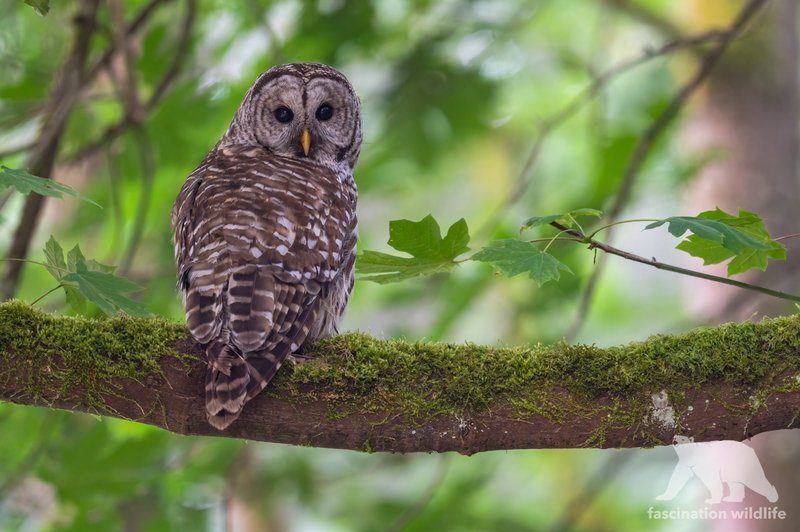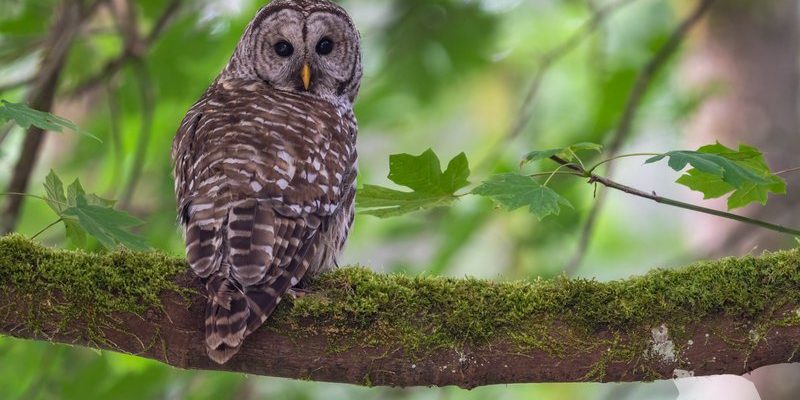
You might be wondering what makes this bird so special. Well, let’s dive into the lesser-known facts about the Barred Owl that might surprise you. These fascinating creatures are more than just their charming calls and fluffy feathers. So, grab a comfy seat, and let’s explore some intriguing insights about this remarkable owl.
1. The Barred Owl’s Unique Appearance
Barred Owls have a distinct look that sets them apart from other owls. They have a round face accented by dark eyes, which give them an almost curious expression. The feathers are beautifully patterned with horizontal bars on the body and vertical streaks on the face, creating a lovely contrast that’s both striking and camouflaging. This makes them blend quietly into the trees where they reside, which is a clever survival tactic.
Another interesting feature is their size. Barred Owls are medium-sized, typically about 16 to 25 inches tall. Their wingspans can reach up to 50 inches! If you ever spot one, you’ll notice how they seem to glide more than flap, making their movements graceful and silent. This is key for a predator that relies on stealth to catch its dinner.
2. Barred Owls Are Adaptable Hunters
Here’s the thing: Barred Owls have a diverse diet that reflects their adaptability. While they mainly feast on small mammals—like mice, voles, and rabbits—they also enjoy a variety of other foods. They aren’t picky eaters! They’ll munch on birds, amphibians, and even fish if the opportunity arises. This flexibility allows them to thrive in various habitats, from dense forests to suburban areas.
Their hunting style is pretty interesting too. Barred Owls typically hunt at night, using their excellent vision and hearing to locate prey. They perch silently on a branch, scanning the ground below. When they spot something, they swoop down with quick precision, making for a successful catch. It’s like they’re performing a perfectly choreographed dance with nature.
3. Vocalizations That Echo Through the Woods
If you’ve ever heard the eerie call of a Barred Owl, you won’t forget it. Their vocalizations are distinctive and can carry for miles. The classic “who cooks for you?” call is often used by adults to communicate with one another, especially during the breeding season. But here’s a fun fact: young Barred Owls also have a different call, which sounds more like a series of raspy whistles.
Their vocalizations serve as a territorial warning, letting other owls know where they stand. It’s a bit like saying, “Hey, this is my turf!” So, if you hear a Barred Owl calling in the distance, it’s likely they’re asserting their presence in the area.
4. The Breeding Habits of Barred Owls
The breeding season for Barred Owls usually kicks off in late winter to early spring. Here’s the thing about their courtship: it’s not just about finding a mate. The male performs a series of elaborate displays, like swooping and calling, to attract a female. Once they pair up, they’ll look for a suitable nesting site, often choosing tree cavities or old nests from other birds.
After the female lays her eggs—usually about 2 to 5—they both take turns incubating them. It’s a cooperative effort! The male will bring food to the female while she’s sitting on the eggs, allowing her to focus on keeping the eggs warm. Once the chicks hatch, they’re completely dependent on their parents for food and protection, which creates a tight-knit family dynamic.
5. A Sanctuary for Barred Owls
Barred Owls thrive in habitats that include mature forests, swamps, and even suburban areas. They prefer places with plenty of trees, which provide them with food, shelter, and nesting spots. They’re often seen near water sources since they hunt for fish and other prey in these areas.
As you might guess, the loss of forest habitats can threaten their survival. Conservation efforts are crucial. By preserving their natural environments, we help keep Barred Owl populations healthy and thriving. You can even help by planting native trees or supporting local conservation groups.
6. Barred Owls and Their Role in the Ecosystem
Barred Owls play a significant role in maintaining the balance of their ecosystems. By controlling the populations of small mammals and other prey species, they act as natural pest controllers. This is beneficial for farmers and gardeners, as it minimizes damage to crops and plants.
However, they also face challenges. As they thrive in suburban areas, they can come into conflict with other wildlife and even pets. Understanding their role can help us coexist with them peacefully. Emphasizing harmony in nature is essential!
7. Common Myths About Barred Owls
Let’s bust a few myths! One common misconception is that Barred Owls are dangerous. While they are predators, they generally pose no threat to humans. They might defend their nests aggressively, but they’d much rather avoid confrontation.
Another myth is that Barred Owls are strictly nocturnal. In reality, they can be active during the day, especially in heavily wooded areas. So, if you’re out hiking and hear their calls, don’t be too surprised to catch a glimpse!
8. The Future of Barred Owls
As we look to the future, the survival of Barred Owls hangs in the balance. They are listed as a species of least concern, but this doesn’t mean their populations are free from threats. Habitat loss and climate change are significant factors that could impact their numbers.
By supporting conservation efforts and being mindful of our natural surroundings, we can help ensure that these magnificent birds continue to grace our forests for generations to come. Educating others about Barred Owls also plays a vital role in their protection.
In conclusion, Barred Owls are remarkable creatures that offer much more than meets the eye. From their unique calls to their vital role in the ecosystem, there’s a lot to appreciate about these fascinating birds. So, the next time you hear that haunting call echoing through the woods, take a moment to appreciate the wonder of the Barred Owl and all that it represents. Let’s keep our eyes and hearts open to the beauty of nature, one owl at a time.

